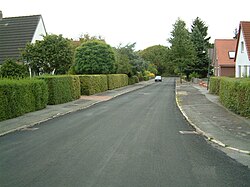Road repairs
Road maintenance (colloquially also called road renovation or lane renovation) describes structural measures and construction methods to remove damage to the surface of roads. There are essentially three different methods used for this.
Thin layers
The application of thin layers can be done in two ways:
Thin asphalt surface layers in cold construction
Asphalt mix for thin asphalt surface layers in cold construction ( DSK for short ) is mixed from the components aggregate , highly modified bitumen emulsion , water and cement by self-propelled machines and applied to the road surface in liquid form. In the transverse profile , unevenness is compensated for, such as B. ruts . The installation takes place at walking pace . After approx. 15-30 min. the rehabilitated route can be used again. The layer thickness of the DSK ceiling is only one centimeter on average. It is a tried and tested maintenance procedure, in particular to restore / increase grip .
The main advantages are:
- Low installation costs
- Low noise pollution for residents
- Low traffic obstruction
- Rapid release for traffic
- Resource conservation
- Can be built over
Thin layers in hot construction
This is a mixture of aggregates and road construction bitumen , which is usually installed with a thickness of ≤ 2 cm. With the help of the thin layers in hot construction ( DSH for short ), cracks in the mesh and breakouts can be eliminated and the grip improved.
Mending
The mending measure is suitable for locally very limited damage areas in the pavement and is usually carried out by hand. In terms of durability, this measure is to be assessed as unsatisfactory.
Complete renovation
In a complete renovation be milling ( Concrete cutting at surface layers of concrete) all asphalt layers removed, and then the supporting , binder newly installed and the cover layer.
Surface treatment
During the surface treatment , only the top layer is renovated. It is also suitable for the intermediate construction of roads . It is characterized by spraying a substrate with a binding agent and then sprinkling it with an aggregate . This application can take place several times. Bituminous binders are mostly used for spraying; and epoxy resins are used. In Germany, broken natural stone is used for scattering; this can be pre-bituminized and / or heated.
Norms and standards
In Germany u. a. the following standards and guidelines must be observed:
- ZTV BEA-StB 09/13 - Additional technical contract conditions and guidelines for the structural maintenance of traffic area pavements - asphalt construction methods
- TLG Asphalt-DSK-StB 98/03 - Technical delivery conditions for asphalt in road construction Part: Quality control, Part: Mixture for thin layers in cold paving (soon to be replaced by TL G DSK-StB 14)
- TLG Asphalt-OB-StB - Technical delivery conditions for asphalt in road construction Part: Quality control, Part: Execution of surface treatments (soon to be replaced by TL G OB-StB 14)
- TL Gestein-StB 04 - Technical delivery conditions for aggregates in road construction
- DIN EN 13043 - aggregates
- TL BE-StB 07 - Technical delivery conditions for bitumen emulsions
Individual evidence
- ↑ Thin-layer asphalt ( memento of the original dated February 12, 2015 in the Internet Archive ) Info: The archive link was inserted automatically and has not yet been checked. Please check the original and archive link according to the instructions and then remove this notice. , VSI GmbH, accessed on August 16, 2012
- ↑ Thin asphalt surface layers in cold construction - DSK , Bitunova GmbH, accessed on August 16, 2012



